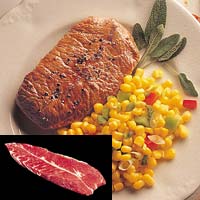Gluten Free
What does following a gluten-free diet mean? That you're embarking on an easy diet with a wide range of health-promoting effects. Instead of dwelling on what you’re giving up, consider that you’re going to enjoy a whole new world of delicious food options to meet your special dietary needs. You’ll be eating seasonally, choosing more fresh fruits and vegetables, focusing on meats, seafood, poultry, legumes, lentils, corn, and rice, and discovering fascinating ancient grains such as quinoa, amaranth, and millet. You’ll be able to eat potatoes, eggs, most cheeses, even chocolate (!)—and enjoy them without guilt because you’ll be taking good care of your body. In fact, you’ll probably end up eating—and feeling—better than ever!
Visit this page for more information about living Gluten Free
---
We carry a large variety of gluten free items, the brands listed below represent just some of the offerings we carry















More Diets
Top Blade Steak

Preparation, Uses, & Tips
Chuck and top blade steaks take well to cooking by either dry or moist heat methods, depending on the cut. If broiling or grilling, always marinate this steak first to tenderize it. Marinades are seasoned liquids containing tenderizing ingredients, either acidic foods such as lemon juice, wine, vinegar, and tomato juice, or natural tenderizers such as pineapple, papaya, or ginger. Place the steak in an acid-resistant container, add meat—and turn the meat to make sure the marinade touches all surfaces. Cover and marinate in the refrigerator for several hours or overnight. Marinades can be added to chuck steak while cooking, but never consume marinades that have come in contact with raw meat unless they haven’t been thoroughly cooked to destroy all microorganisms.
Broil
Marinate the steak first. Then preheat the broiling element and place the steak on a broiler pan 2 to 4 inches (5–10cm) from the heat source. Depending on the size, cook for 14 to 17 minutes, turning once. Remove the steak when it reaches desired degree of doneness—145°F (63°C) for medium rare or 160°F (71°C) for medium. An instant-read thermometer may help you judge the time. Steaks good for broiling include top blade, shoulder, chuck eye, and seven-bone.
Grill
Marinate the steak first. Then place the meat, either whole or as kabobs, directly over the heat source. Grill 8 to 18 minutes, depending on the thickness of the meat. Good grilling steaks include top blade, shoulder, and seven-bone.
Pan-broil
Marinate the steak first. Then heat a skillet on the stovetop until hot. Place the meat on the skillet and cook 8 to 10 minutes, turning once. Remove the steak when it reaches the desired degree of doneness. Good pan-broiling steaks include top blade, shoulder, and chuck eye.
Pan-fry
Marinate the steak first. On the stovetop, heat oil in a skillet until medium hot and place the steak in the pan. Cook on each side until the meat reaches an internal temperature of 145°F (63°C) for medium rare or 160°F (71°C) for medium. Good steaks for pan-frying include top blade, shoulder, and chuck eye.
To braise, heat oil in a deep skillet on the stovetop and brown the steak on both sides. Add cooking liquid and seasonings. Reduce the heat and simmer until tender, 3 1/2 to 4 hours. All the chuck steaks lend themselves to braising.
Copyright © 2025 TraceGains, Inc. All rights reserved.
Learn more about TraceGains, the company.
The information presented in the Food Guide is for informational purposes only and was created by a team of US–registered dietitians and food experts. Consult your doctor, practitioner, and/or pharmacist for any health problem and before using any supplements, making dietary changes, or before making any changes in prescribed medications. Information expires December 2025.











